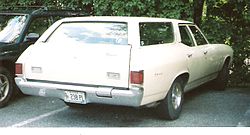- Chevrolet Greenbrier
-
Chevrolet Greenbrier 
Manufacturer General Motors Production 1961-1965
1969-1972Successor Chevrolet Van (For 1965) Class Van (1961-65)
Mid-size station wagon (1969-1972)The name Chevrolet Greenbrier was used by the Chevrolet division of General Motors for two vehicles, the first one being a van based on the Corvair and produced in the model years 1961 to 1965. During the model years 1969 to 1972 a station wagon of the Chevelle took over this name.
Contents
1961-1965 Corvair Greenbrier Sportswagon
First generation 
Production 1961-1965 Body style 6-door van
8-door vanLayout RR layout Platform Y-body Engine 2.4 L H6
2.7 L H6Transmission 2-speed automatic
3-speed manual
4-speed manualWheelbase 95.0 in (2,413 mm) Related Chevrolet Corvair Chevrolet introduced the Corvair line up for the 1960 model year as the first of a series of generations of passenger compact cars. Chevrolet introduced a more utilitarian style of vehicle the following year under the model designation "Corvair 95". In appearance and technical principals the vehicles were similar to the competing Volkswagen Transporter which was essentially a bus-like cab over adaptation of the Volkswagen Beetle which moved the driver over the front wheels.
Power came from the Corvair's horizontally air-cooled opposed 6 cylinder engine fitted to the rear of the car under a slightly raised cargo floor. It was similar in principle to the 4 cylinder engine of the Volkswagen, but unusual for most contemporary cars. Its displacement was 145 cu in (2,375 cc) and it developed 80 hp (60 kW) at 4,400 rpm. The engine size was increased to 164 cu in (2,683 cc) for the 1964 model year, meaning power went up to 95 hp (71 kW). Unlike the Corvair cars these vehicles had a 95 in. wheelbase and were known as 95s because of the wheelbase. They came standard with a manually operated three-speed gearbox but could be ordered with a two-speed powerglide automatic transmission and eventually a four-speed manual was also made available.
There were essentially two different bodies available in the 95 series: the van and the truck. The simplest version was the panel van (Corvan) where no side or rear windows were to be found; The van upgrade was the Greenbrier. The Greenbrier normally had windows all around and six doors, although a rare option was to have eight doors where there were opening double doors on both sides. The Greenbrier could seat up to nine people with the available three seat option. The 95s and cars had an optional gas heater running off of gas from the vehicle's tank. The Greenbrier also had a camper option available that made it quite the weekend family get away vehicle.
The truck body consisted of the "Load side" and "Ramp side". The Load side was essentially a pickup with a standard tail gate only. The Loadside was only produced 2 years and is the rarest of the Corvairs. Only 369 were ever produced. A much more useful version of the truck was the Rampside. The Rampside had a side ramp to be used for loading / unloading. This was used very commonly by Bell System because loading / unloading of cable drums was eased by the side ramp.
As Ford and Chrysler introduced the Ford Econoline and Dodge A100 compact vans of their own using a more conventional water-cooled engine mounted between the front seats, General Motors produced a similar van of their own. General Motors stopped producing the truck versions of the Corvair in 1964 and the Greenbrier was the sole survivor of the 95 inch wheelbase Corvair for 1965. Although the Greenbrier were a limited success, passenger vans would continue to evolve through full-sized vans and the 7-8 passenger minivan which would become a very successful vehicle niche by the 1980s as alternatives to station wagons.
1969-1972 Chevelle Greenbrier
During the model year 1969 the four-door station wagons of the mid-sized Chevrolet Chevelle, produced since 1964, achieved additional names. The lowest, standard station wagons hitherto known as the Chevelle 300 series 131 / 132 got the Nomad name, while the medium Chevelle 300 Deluxe series 133 / 134 range was now called the Greenbrier. The top-of-the-line models, Chevelle Malibu 135 / 136 series, simply became the Concours and Concours Estate Wagon. The latter is decorated with exterior woodgrain paneling. Except for the simplest Nomad line (which was only available in six-seater form), all station wagons could be ordered with either six or nine seats. Power came from inline-sixes (not available for nine-seaters) or V8 engines.For 1970, the Chevelle 300 Deluxe series was simply called Chevelle and the inline-six engine was no longer available in the station wagons. In 1972 the series' model code was changed to 1C. The Nomad, Greenbrier, and Concours names were all dropped for 1973, when the Chevelle was redesigned and the wagons all began sharing series names with other body styles.
References
John Gunnell (Editor): Standard Catalog of American Cars 1946-1975, Krause Publications Inc., Iola (2002), ISBN 0-87349-461-X
Categories:- Chevrolet vehicles
- Mid-size cars
- Rear wheel drive vehicles
- Vans
- Station wagons
- 1960s automobiles
- 1970s automobiles
- Motor vehicles manufactured in the United States
Wikimedia Foundation. 2010.


